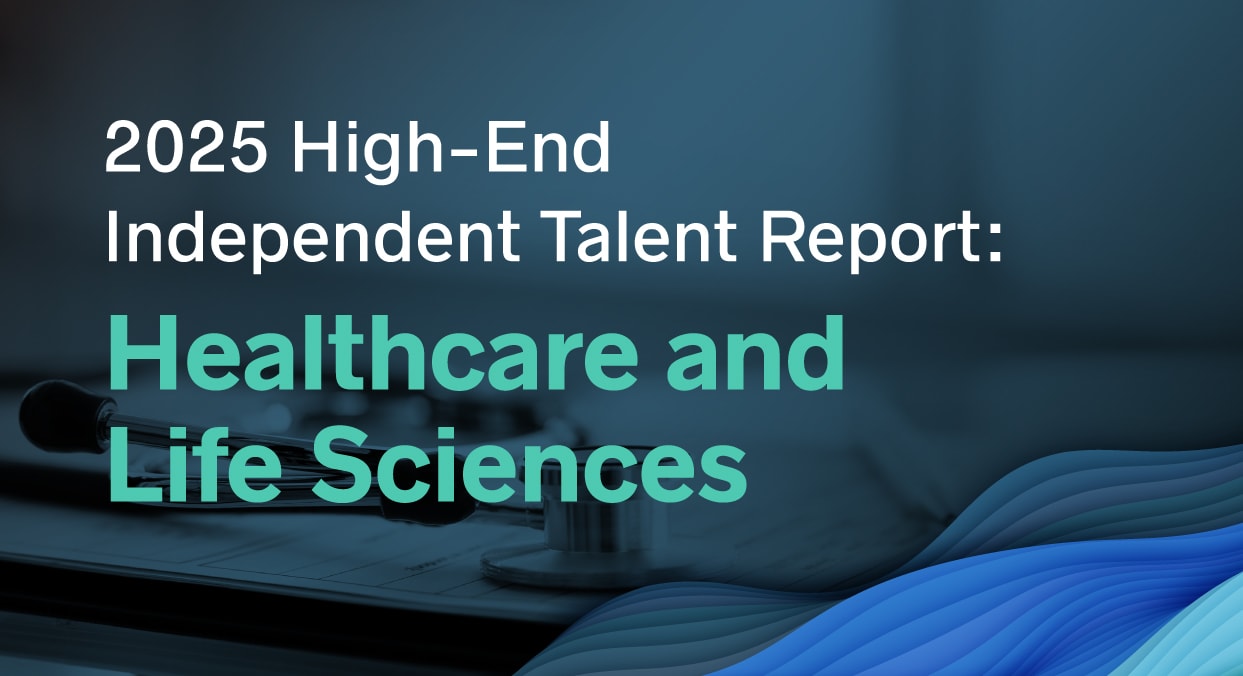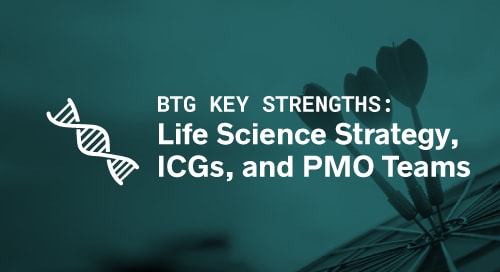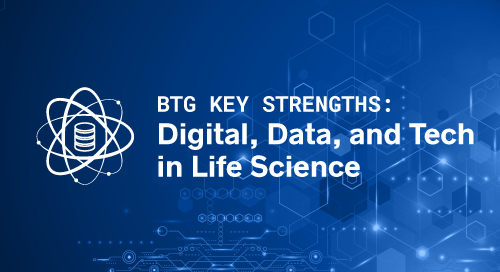In this time of global uncertainty, it’s more important than ever for business leaders to engage in ethical decision-making that benefits not only the company’s bottom line and shareholders, but also the communities, customers, and employees who rely on them.
In this episode of the BTG Insights on Demand podcast, BTG client John O’Hara, Vice President of Strategic Initiatives at the Janssen Pharmaceutical Companies of Johnson & Johnson and leader of J&J’s Pharmaceutical Supply Chain Crisis Task Force, joins BTG Managing Director Sharon Chae Haver to discuss the changes that the COVID-19 pandemic has brought to pharma manufacturing and supply chain. They also delve into the importance of having a clear set of ethical principles by which to guide decision-making in the rapidly shifting business environment.
Listen to the podcast to hear John’s take on ethical decision-making frameworks can help companies build resilient and efficient supply chains in the age of COVID-19. You can also read our lightly edited transcript of the chat below.
You've been in pharmaceutical manufacturing and supply chain for most, if not all of your career, could you please walk us through the main roles and responsibilities that you've had and what you're focused on currently?
Really I've been in supply chain my entire career, even when I was a co-op student as a mechanical engineer back in college. But I've been with J&J now for 24 years, with the first eight of those spent in our medical device sector. Then I came to pharmaceuticals for the last 16 years—with roles in our small molecule API manufacturing, where I was an engineer and then the site general manager. I then transferred to oral solid dose manufacturing for four years as the general manager of our plant in Gurabo, Puerto Rico, and then I had the opportunity to take on a non-Make Center role in our demand and affiliate supply team. These last couple of years, I've been leading a number of our strategic programs and projects in our network. And then most recently with the outbreak of COVID-19, I've been leading our Pharma Supply Chain Crisis Task Force.
You’ve had such a well-rounded set of roles within pharma supply chain, and now you're really in the center of this global health crisis as the leader of the Pharma Supply Chain Crisis Task Force. At the same time, the safety and the effectiveness of our pharmaceutical chain has always been a critical issue. In what ways has this pandemic and your leadership role in addressing this crisis changed the way you and your team work and in what ways have things stayed the same?
That's a great question. I think it's interesting for us to kind of step back a bit and think about how we're all working in these new times with social distancing and working from home. And for me, it's been about finding even more creative ways to make use of our digital tools and how to work across our teams using, say, Skype or Zoom or Microsoft teams. The ability to have everyone's cameras on and keep and maintain those connections, it's just been so critical.
Let me also say that I couldn't be more proud of our people in the manufacturing plants who continue to go to work every day in this new normal to make the important compounds and medicines that are just so critically important every day. They've done and really continue to do just a tremendous job.
But as I think about our taskforce and the work that we're doing across the supply chain, the rate of change has been astounding. It was certainly fast before COVID-19, but in light of the pandemic and its implications across our supply chain, it's just been incredible.
For instance, the implications on air travel. As we've seen the amount of passenger flights greatly reduced, it's really impacted our ability to move material and has required just constant triage from our transportation organization.
Similarly with our suppliers. We had an issue just last week where we needed material from one of our suppliers in the U.S. to get to one of our European facilities within a couple of days and yet our supplier was being quoted two weeks transportation. But with the help of our logistics team, we were able to step in and find alternatives that allowed us to get the material just in time and not risk our production window. So just an incredible job on their part—but getting back to your question, I think what's really changed is the need to stay on top of all of our supply chain processes and deploy teams rapidly that have the right skills and competencies and decision making authority to make things happen.
It's obvious from your examples that having a very clear set of principles, decision-making authorities, and a governance structure to guide your decisions in real time is more important than ever in responding to this pandemic and the ever-changing next normal. To address this need J&J recently created an ethical decision framework—based on the J&J Credo—to help manage your response.
Could you please tell us more about the J&J Credo and the ethical decision framework? How are they driving your short-term response to COVID-19 and the long-term decisions for what's next?
Absolutely, let me first start with our Credo. It was written by Robert Wood Johnson in 1943, just prior to J&J becoming a publicly traded company. What's amazing though, is that he wrote our Credo long before anyone had really ever heard of Corporate Social Responsibility.
Our Credo really sets forth our priorities in four very clear paragraphs. The first is to our patients, doctors, nurses, mothers, and fathers who use our products and that they must be of the highest quality. The second paragraph is dedicated to our employees across the world, in that we must provide an inclusive work environment where each person must be considered as an individual. The third to our communities where we live and work. And then lastly, the fourth paragraph to our shareholders.
What I think is most telling in this paragraph is how General Johnson stated it. It says, "When we operate according to these principles, the stockholders should realize a fair return." The use of the word “should,” has really struck me over the course of my 24 years with J&J. It was the very first hook when I read this prior to my interviews—using the word “should” was just so powerful to me.
Now, in light of COVID-19, we've created the ethical framework—through the office of our chief medical officer—to guide our decisions. That was developed with internal and external experts and provides an ethics-based framework for decision-making and how we'll allocate supply. It's absolutely consistent with our Credo and emphasizes on reducing suffering, saving the greatest number of lives, and supporting those on the frontline.
There are four key priorities in our ethical framework. First and foremost, to maintain supply for patients who currently rely on the treatment. Second, the supply for well randomized controlled clinical trials. Third, other supplies to studies or registries that may not be designed or randomized as a controlled clinical trial, but they're important nonetheless. And then lastly, allocating the remaining supply as fairly as possible. We've worked to bring these together as part of a holistic decision-making framework across all of J&J.
Ethical and socially responsible frameworks are so necessary to everyone who has to make difficult resource allocation decisions in facing the pandemic, and hopefully, other organizations in life sciences and other industries are following suit.
Speaking of difficult decisions, many conversations are happening around this trade-off between cost efficiency and flexibility of our supply chains. There's a notion that the relentless drive to be lean and as efficient as possible has perhaps left our supply chains vulnerable to disruptions like this pandemic, and that it can lead to critical shortages—especially in this industry. So how do you think about these trade-offs and what strategies would you recommend to prepare for such disruptions?
These are times that really stress our BCPs or business continuity planning, as well as our supply chain risk management across our total value chains. What are these? It’s really how we approach risk across our supply chain at all of our nodes, and how we look to reduce these risks through careful planning and backups. Now these backups can be alternate teams in place to carry out a function, could be alternate manufacturing sites or suppliers, or it could be through inventory at a given node or nodes within the supply chain—or really any mix of these, just to name a few. But really the key point is that you've proactively thought through the implications on your supply chain, how to manage these risks and what steps you want to have in place, and/or what those trigger points are.
Now, additionally, before there's an issue you really want to go in and test your responses, learn from these tests and make your plans and your supply chain stronger and more effective. Thinking from a very personal perspective, we have many compounds in our portfolio that are critical to our customers. Back to that first paragraph of our Credo that I discussed, it could be someone's mother, father, sister, brother, or a frontline worker depending on that medicine to be in the right place at the right time.
Now, as I think about the COVID-19 pandemic, it'll be critical for all of us to go back through our thinking and ensure that we run a full lessons-learned on our supply chain and our responses to this—and then turn these lessons into action and make the necessary changes, so that we are more robust in the future for when and if we see something like this for whatever the next issue might be.
Get the Skills You Need
Thousands of independent consultants, subject matter experts, project managers, and interim executives are ready to help address your biggest business opportunities.





















